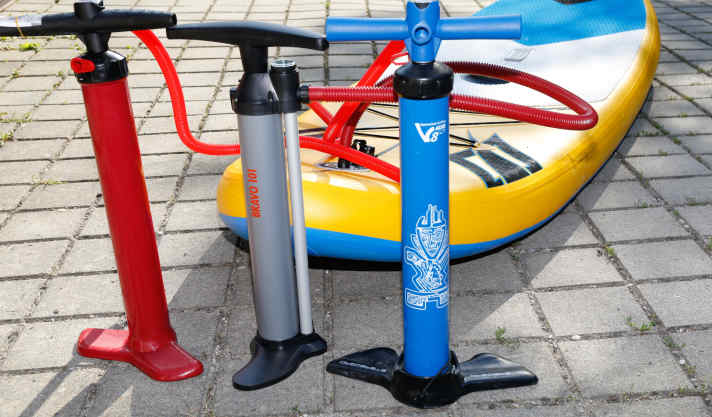
One SUP pumpmust not only generate the necessary pressure, but in addition to the actual pressure build-up, you are also always pumping against the "internal resistance" of the pump. This is the energy required just to pump the air through the ducts and flaps, even at zero back pressure. In conventional pump designs, the hose is flanged to the handle, so the air always has to pass through the piston tube from below when pulling and pushing. On top of this, the air is channelled through valve flaps in the actual piston.

This is particularly important in the initial phase until the board is completely filled with air but without any significant pressure. After all, when pulling and pushing, small rubber flaps inside the pump have to close small passages in one direction and then open them in the other direction. The air follows a veritable labyrinth through the pump housing.
The principle is completely broken with the Bravo 100. When pushing, the air flow goes directly downwards through the external pipe and back up into the hose. When pulling, the air path above the piston goes directly into the hose. The piston itself is completely closed and has no openings.
Consequence: The pump runs with extremely reduced internal friction, especially in the initial phase you might think there is a defect because there is no resistance at all. The first 100 pump strokes are achieved with very little effort. Another very positive aspect is that the hose is attached to the cylinder and does not move when pumping.
How did the Bravo 100compared with two pumps. It should be noted that most series pumps are also manufactured by Bravo and are sometimes supplied identically to the boards by the various brands.
The model on the left in the pictureis a standard pump supplied by some manufacturers, such as Gunsails here. With a fixed foot and without the option of suction. The pump works well, but the Bravo 100 runs much more easily even when idling. Despite the slightly lower lift height, the board is filled just as quickly with the Bravo 100.
The "tuned" series pump variant as with Starboard (pictured right) not only offers a removable base and the option of a connection for suction. The diffusers inside are significantly larger, which reduces internal losses. This has a clearly positive effect.
At higher pressures - however, the Bravo 100 makes a distinct hissing noise when pulling, especially when pumping at a high frequency. Both comparison pumps run much more quietly.
Conclusion:If you already have a very good pump (like the one from Starboard), the Bravo 100 is only a marginal improvement, but you also have to accept some compromises (no suction, no removable stand). After the first 100 strokes, the difference is hardly noticeable when the board is fully pressurised. Compared to the other, already neat, current standard pumpthe Bravo 100 can initially be pumped with virtually no force, especially at a leisurely frequency. If you pump extremely quickly, you will feel at least a slight resistance when pulling and hear a subtle hiss. With "normal" speed pumping, the piston can initially be moved with two fingers on the handle.And until the end, the Bravo 100 has a more energy-saving effect.are in the inventory, possibly even without the "double stroke", then a change is definitely worthwhile.
